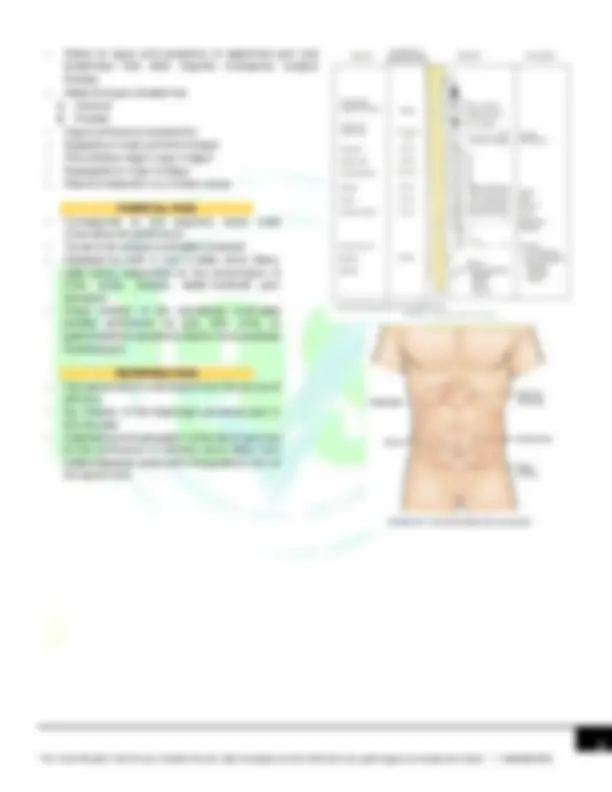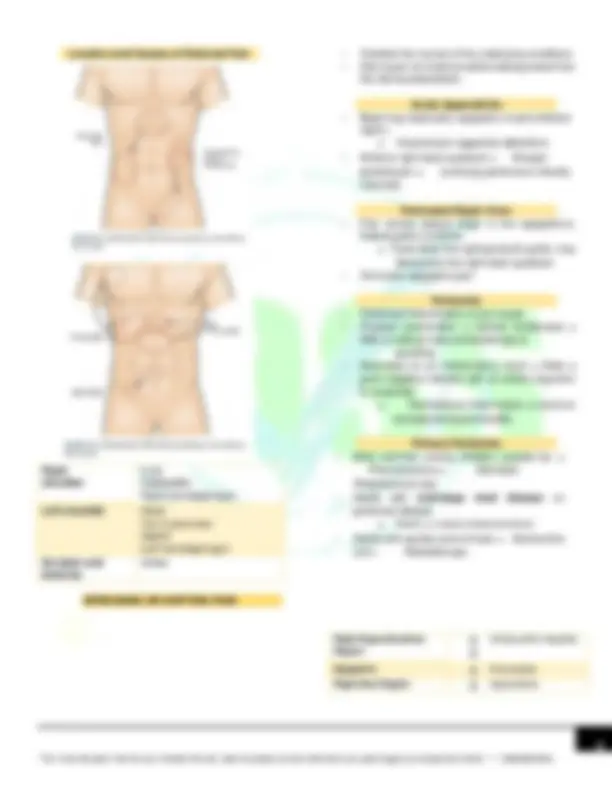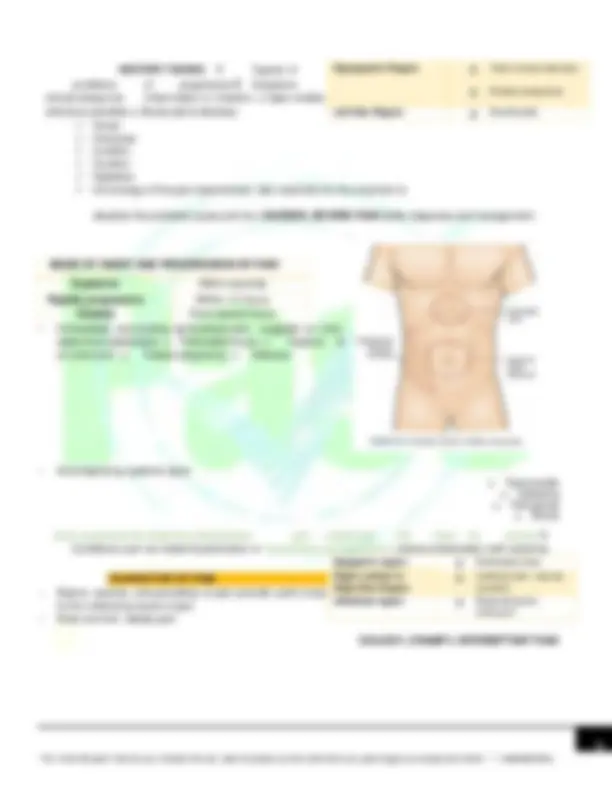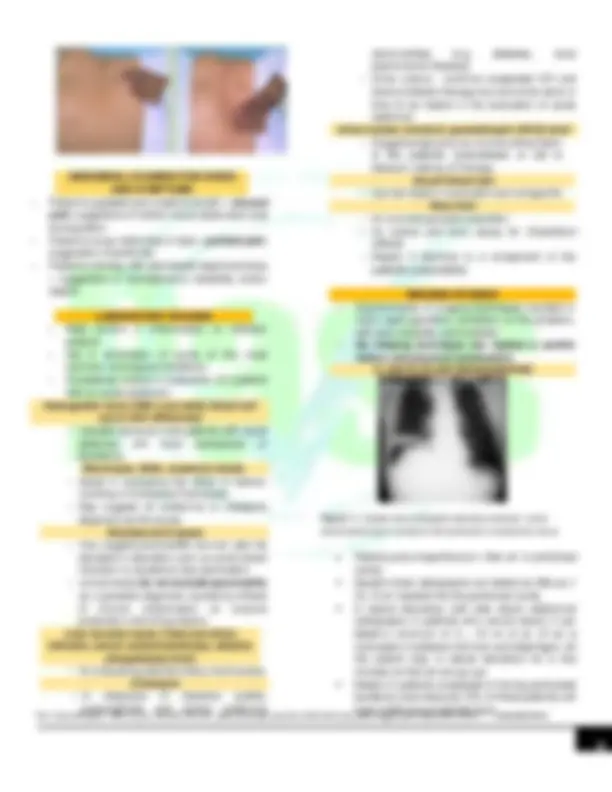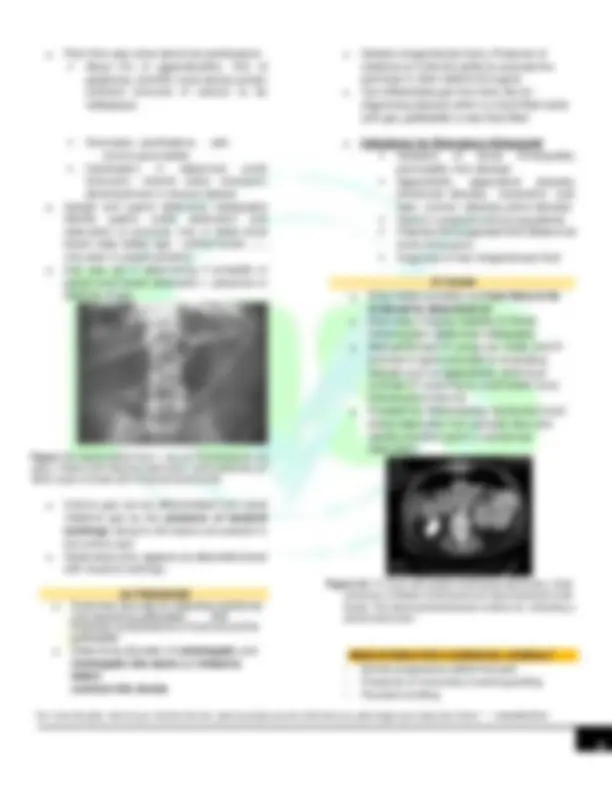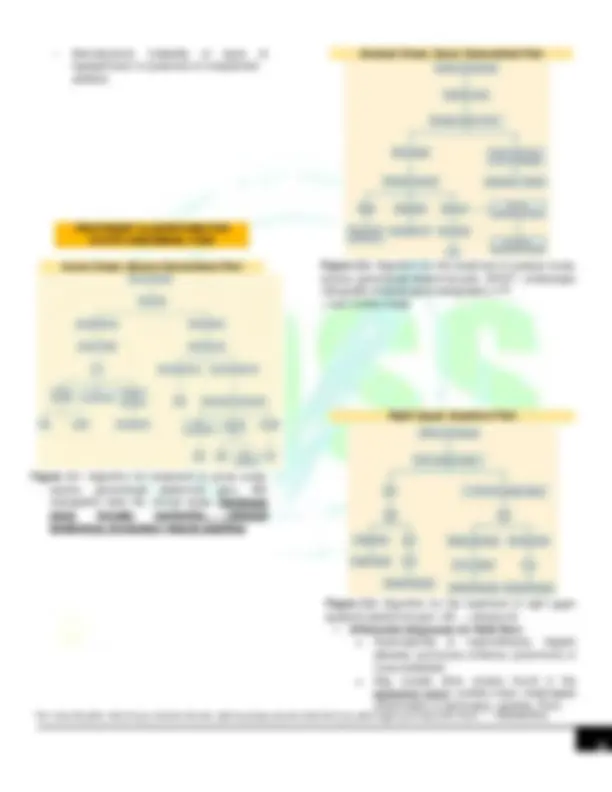Download _abdominal_pain.pdf_abdominal_pain.pdf and more Exams Nursing in PDF only on Docsity!
“'For I know the plans I have for you,' declares the Lord, 'plans to prosper you and not to harm you, plans to give you a hope and a future. '” — Jeremiah 29:
“'For I know the plans I have for you,' declares the Lord, 'plans to prosper you and not to harm you, plans to give you a hope and a future. '” — Jeremiah 29:
Appendix, colon, and pelvic viscera Mesenteric plexus and lesser splanchnic nerve
T10- 11
Sigmoid colon, rectum, kidney, ureters, and testes Lowest splanchnic nerve
T10- 11
Bladder & rectosigmoid Hypogastric plexus
S2- 4
TOPIC OUTLINE
I. Acute Abdomen II. Anatomy and Physiology A. Visceral pain B. Parietal pain C. Referred pain D. Shifting pain III. History taking A. Pain B. Other symptoms associated C. Regions of the abdomen IV. Physical Examination A. Inspection B. Percussion C. Palpation D. Abdominal examination signs V. Laboratory studies VI. Imaging studies VII. Indications for surgical consult ACUTE ABDOMEN ANATOMY AND PHYSIOLOGY VISCERAL PAIN SENSORY LEVELS ASSOCIATED WITH VISCERAL STRUCTURES STRUCTURES NERVOUS SYSTEM PATHWAYS
SENSORY
LEVEL
Liver, spleen and central part of diaphragm Phrenic nerve C3- 5 Peripheral diaphragm, stomach, pancreas, gallbladder, and small bowel Celiac plexus and greater splanchnic nerve
T6- 9
DR.
MARAMBA
“'For I know the plans I have for you,' declares the Lord, 'plans to prosper you and not to harm you, plans to give you a hope and a future. '” — Jeremiah 29:
Location and Causes of Referred Pain Right shoulder Liver Gallbladder Right hemidiaphragm Left shoulder Heart Tail of pancreas Spleen Left hemidiaphragm Scrotum and testicles Ureter SPREADING OR SHIFTING PAIN
- Parallels the course of the underlying conditions
- Site of pain at onset should be distinguished from the site at presentation. Acute Appendicitis
- Beginning classically: epigastric or periumbilical region. o Visceral pain (appendix distention)
- Shifts to right lower quadrant o Sharper parietal pain o (overlying peritoneum directly inflamed) Perforated Peptic Ulcer
- Pain almost always begin in the epigastrium, leaked gastric contents o Track down the right paracolic gutter, may descend to the right lower quadrant
- Diminution epigastric pain Peritonitis
- Peritoneal inflammation of any cause
- Physical examination o Severe tenderness o With or without rebound tenderness & guarding
- Secondary to an inflammatory insult o Often a gram-negative infection with an enteric organism or anaerobe o Noinfectious inflammation, a common example being pancreatitis Primary Peritonitis
- More common among children, caused by: o Pneumococcus o Hemolytic Streptococcus spp.
- Adults with end-stage renal disease on peritoneal dialysis o Gram (+) cocci (most common)
- Adults with ascites and cirrhosis o Escherichia coli o Klebsiella spp. Right Hypochondriac Region Cholecystitis Hepatitis Epigastric Pancreatitis Right Iliac Region Appendicitis
“'For I know the plans I have for you,' declares the Lord, 'plans to prosper you and not to harm you, plans to give you a hope and a future. '” — Jeremiah 29:
HISTORY TAKING Typical of conditions of progressive Questions should always be: inflammation or infection. o Open-ended, whenever possible o Structured to disclose: ✓ Onset ✓ Character ✓ Location ✓ Duration ✓ Radiation ✓ Chronology of the pain experienced- also important for the examiner to decipher the probable cause and for a SUDDEN, SEVERE PAIN better diagnosis and management.
- Unheralded, excruciating generalized pain suggests an intra- abdominal catastrophe o Perforated viscus o Rupture of an aneurysm o Ectopic pregnancy o Abscess
- Accompanying systemic signs o Tachycardia o Sweating o Tachypnea o Shock Soon supersede the abdominal disturbances and underscore the need for prompt Conditions such as intestinal perforation or resuscitation and laparotomy arterial embolization with ischemia. CHARACTER OF PAIN
- Nature, severity, and periodicity of pain provide useful clues to the underlying cause of pain
- Most common: steady pain COLICKY, CRAMPY, INTERMITTENT PAIN Hypogastric Region Tubo-ovarian abscess Ectopic pregnancy Left Iliac Region Diverticulitis MODE OF ONSET AND PROGRESSION OF PAIN Explosive Within seconds Rapidly progressive Within 1-2 hours Gradual Over several hours Epigastric region Perforated Ulcer Right Lumbar to Right Iliac Region Ureteral colic- may be constant Umbilical region Ruptured aortic aneurysm
“'For I know the plans I have for you,' declares the Lord, 'plans to prosper you and not to harm you, plans to give you a hope and a future. '” — Jeremiah 29:
Figure 5. Ecchymoses. (L) Periumbilical bruising is a (+) Cullen’s sign; it means there is hemoperitoneum. (R) Local areas of discoloration around umbilicus and flanks give a (+) Grey Turner’s sign; it means there is acute hemorrhagic pancreatitis. AUSCULTATION
- Listen to the abdomen before performing percussion or palpation because the maneuvers may alter the frequency of bowel sounds.
- Auscultate away from pain just like when you palpate to avoid more pain the area
- ALWAYS listen for the whole 1-- 2 minutes; No shortcuts! This is because unlike heart sounds, bowel sounds do not come in regular rhythms.
- Bowel sounds are typically evaluated for their quantity and quality: o A quiet abdomen suggests an ileus. Listen for 1 -- 2 whole minutes before declaring absent bowel sounds. o Hyperactive bowel sounds are found in enteritis and early ischemic intestine
- The pitch and pattern of the sounds are also considered: o High-- pitched tinkling sounds (that tend to come in rushes and are associated with pain) are suggestive of mechanical intestinal obstruction. o Far-- away “echoing” sounds are often present when significant luminal distention occurs. o Bruits heard within the abdomen reflect turbulent blood flow within the vascular system The clinician can also subtly test for the location and degree of pain during the auscultatory exam by varying the position and amount of pressure applied with the stethoscope. These data can then be compared with the findings during palpation and evaluated for consistency.
PERCUSSION
- Percussion is used to assess for gaseous distention of the bowel, free intra-- abdominal air, degree of ascites, or presence of peritoneal inflammation.
- Hyperresonance (or tympany to percussion), is characteristic of underlying gas-- filled loops of bowel. If localized dullness to percussion is identified anywhere other than the right upper quadrant (where the liver is), an abdominal mass displacing the bowel is considered.
- When liver dullness is lost and resonance is uniform throughout, free intra-- abdominal air is suspected
- Ascites is detected by looking for fluctuance of the abdominal cavity (check for shifting dullness) o To differentiate from movement of adipose tissue in the obese abdomen, a fluid wave test can be done. PALPATION
- Palpation typically provides more information than any other single component of the abdominal exam.
- It confirms findings from the previous steps of physical examination.
- Palpation always begins gently and away from the reported area of pain. If considerable pain is induced at the outset of palpation, the patient is likely to voluntarily guard and continue to do so, limiting the information obtained.
- Perform superficial and deep palpation
- Use the pulp of the fingers and not the tip
- Ask the patient to pinpoint the area of maximal tenderness
- Examine the most tender area last
- Check for peritoneal irritation (most of the time, suggests a surgical abdomen) by looking for presence of:
- cough tenderness
- rebound tenderness (can also be elicited by percussing)
- involuntary muscle guarding (for children: tickle and then touch both sides of the abdomen; If left side relaxes and right side remains hard involuntary)
- Check for organomegaly Figure 6. Palpation of the Abdomen. (L) Light palpation. (R) Two-- handed deep palpation.
“'For I know the plans I have for you,' declares the Lord, 'plans to prosper you and not to harm you, plans to give you a hope and a future. '” — Jeremiah 29:
ABDOMINAL EXAMINATION SIGNS
AND SYMPTOMS
- Patient is agitated and unable to lie still – visceral pain ; suggestive of hollow viscus obstruction and strangulation
- Patient is lying motionless in bed – parietal pain ; suggestive of peritonitis
- Patient is drowsy with decreased responsiveness
- suggestive of hemodynamic instability and/or sepsis LABORATORY STUDIES
- Help confirm if inflammation or infection present
- Aid in elimination of some of the most common nonsurgical conditions
- Considered routine in evaluation of a patient with an acute abdomen: Hemoglobin level (CBC) and white blood cell count with differential
- valuable because most patients with acute abdomen will have leukoytosis or bandemia. Electrolyte, BUN, creatinine levels
- Assist in evaluating the effect of factors: vomiting or third place fluid losses
- May suggest an endocrine or metabolic diagnosis as the cause Amylase and Lipase
- may suggest pancreatitis but can also be elevated in disorders such as small bowel infarction or duodenal ulcer perforation
- normal levels do not exclude pancreatitis as a possible diagnosis caused by effects of chronic inflammation on enzyme production and timing factors Liver function tests (Total and direct bilirubin, serum aminotransferase, alkaline phosphatase level)
- for evaluating potential biliary tract causes Urinalysis
- In diagnosis of bacterial cystitis, pyelonephritis and certain endocrine abnormalities (e.g. diabetes, renal parenchymal disease)
- Urine culture-- confirms suspected UTI and direct antibiotic therapy but cannot be done in time to be helpful in the evaluation of acute abdomen Urine human chorionic gonadotropin (HCG) level
- Suggest pregnancy as a confounding factor in the patient’s presentation or aid in decision making on therapy Occult blood test
- Can be helpful in evaluation but nonspecific Stool test
- for ova and parasite evaluation
- for culture and toxin assay for Clostridium difficile
- Helpful if diarrhea is a component of the patient’s presentation IMAGING STUDIES
- Improvements in imaging techniques resulted in more rapid operative correction of the problem, with less morbidity and mortality.
- No imaging technique can replace a careful history and physical examination X-- RAYS (PLAIN RADIOGRAPHS) Figure 1.1. Upright chest radiograph depicting moderate-- sized pneumoperitoneum consistent with perforation of abdominal viscus. o Detects pneumoperitoneum (free air in peritoneal cavity) ▪ Upright chest radiographs can detect as little as 1 mL of air injected into the peritoneal cavity ▪ In lateral decubitus ( left side down) abdominal radiographs in patients who cannot stand, it can detect a minimum of 5-- 10 ml of air (If air is insinuated in between the liver and diaphragm, let the patient stay in lateral decubitus for a few minutes so that air can go up) ▪ Helpful in patients suspected of having perforated duodenal ulcer because 75% of these patients will have visible pneumoperitoneum.
“'For I know the plans I have for you,' declares the Lord, 'plans to prosper you and not to harm you, plans to give you a hope and a future. '” — Jeremiah 29:
- Hemodynamic instability or signs of hypoperfusion or presence of unexplained acidosis TREATMENT ALGORITHMS FOR ACUTE ABDOMINAL PAIN Acute Onset, Severe Generalized Pain Figure 2.1 : Algorithm for treatment of acute onset, severe, generalized abdominal pain. NG nasogastric tube; NL normal study. Peritoneal signs include: peritonitis, rebound tenderness, involuntary muscle guarding Gradual Onset, Sever Generalized Pain Figure 2.2: Algorithm for the treatment of gradual onset, severe, generalized abdominal pain. ERCP – endoscopic retrograde cholangiopancreatography; LFT
- liver function tests Right Upper Quadrant Pain Figure 2.3: Algorithm for the treatment of right upper quadrant abdominal pain. US -- ultrasound ✓ Differential diagnoses for RUQ Pain: o Pyelonephritis or nephrolithiasis, hepatic abscess, pulmonary embolus, pneumonia or musculoskeletal o May include other causes found in the epigastrial region: cardiac origin, esophageal inflammation or perforation, gastritis, PUD,
“'For I know the plans I have for you,' declares the Lord, 'plans to prosper you and not to harm you, plans to give you a hope and a future. '” — Jeremiah 29:
biliary colic, pancreatitis Left Upper Quadrant Pain Figure 2.4: Algorithm for the treatment of LUQ pain. ✓ Differential diagnoses for LUQ Pain: o Ruptured spleen, splenomegaly, gastric ulcer Right Lower Quadrant Pain Figure 2.5 : Algorithm for the treatment of right lower quadrant abdominal pain. Hx – history; OR-- operation; UTI – urinary tract infection ✓ Differential diagnoses for RLQ Pain: o Meckel’s diverticulum, Crohn’s disease, diverticulitis, salpingitis, ectopic pregnancy Left Lower Quadrant Pain Figure 2.6 : Algorithm for the treatment of left lower quadrant abdominal pain. SUMMARY
- Importance of accurate history taking and complete PE
- Early decision of whether the patient needs urgent surgery
- It is more important to detect immediate life threatening conditions than arriving at the correct diagnosis
- even if you don’t have the correct diagnosis, it is better to have a live patient with an unsure diagnosis rather than a dead patient
- Diagnosing early abdominal pain is difficult. You need to re-- examine the patient after adequate resuscitation
- Differentiate surgical from non-- surgical abdomen
- Make the patient comfortable and pain-- free if possible
- give pain relievers
- Opioids don’t mask physical signs or prevent accurate diagnosis
- Think of the more common surgical conditions first – not the 1% incidence of abdominal pain. Most common surgery performed is cholecystectomy – which presents as a RUQ pain.

